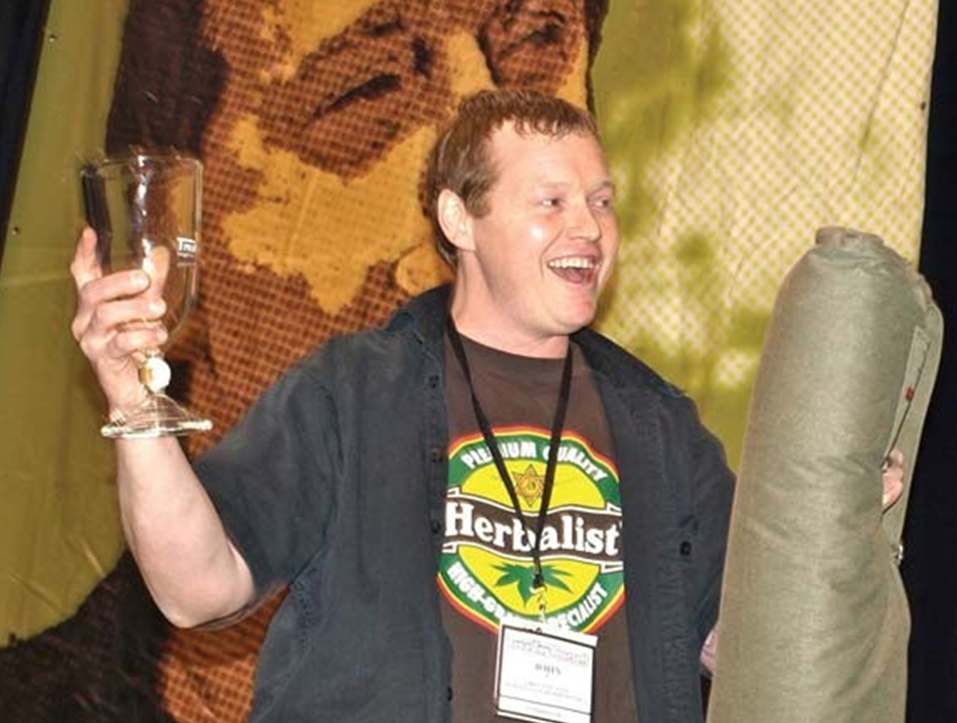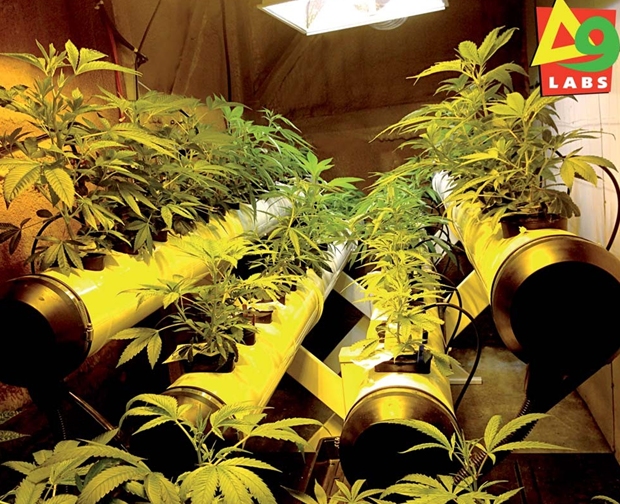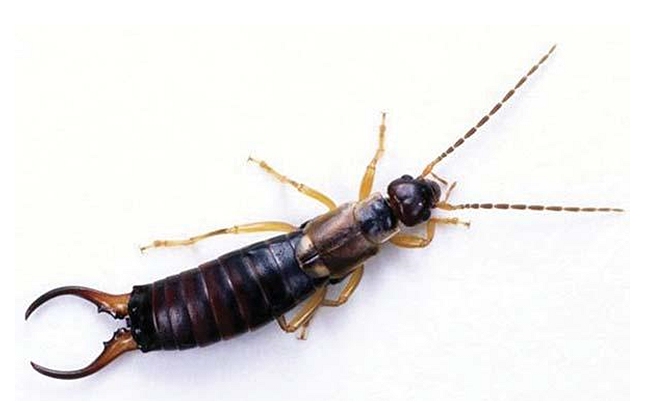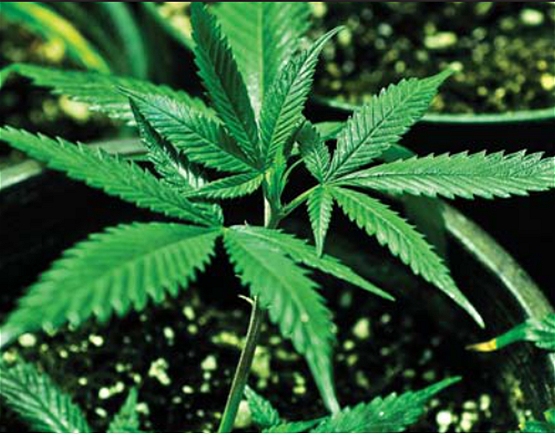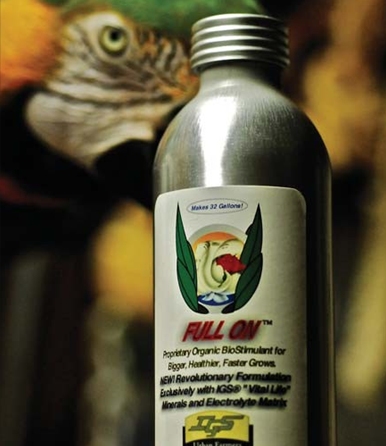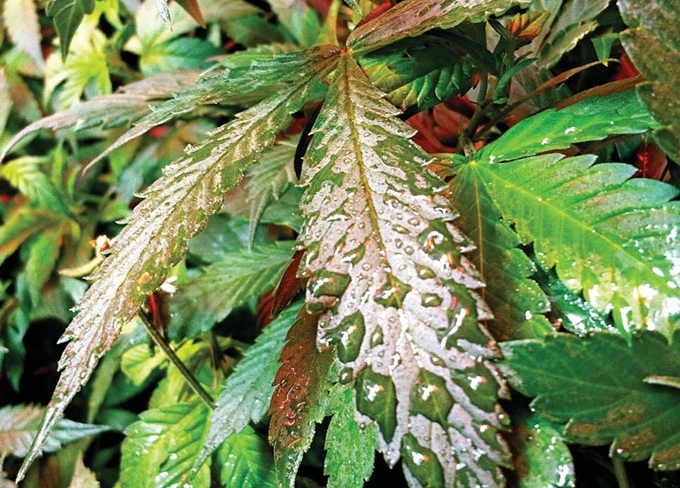
Reaching a Higher Lever with Foliac Feeding
Foliar feeding is a process used to feed nutrients to a plant by absorption through the leaves into the plant tissue by way of the stoma.
Stomata are tiny little pores on the underside of the leaves that are able to intake nutrients and carbon dioxide. Foliar feeding has been used and researched by growers for many years and can be a very efficient way to provide nutrients to a plant, providing great benefits to a grower in most stages of plant life when used correctly.
A great advantage of feeding nutrients through the leaves is that a cannabis plant is able to intake nutrients through foliar sprays more quickly than through the root zone. But foliar sprays pose the risk of over-feeding the plants and causing more damage than repair. Creating a foliar feed- ing nutrient schedule and knowing when to use it will ensure adequate foliar feeding.
There are many different purposes and uses for foliar feed- ing, including nutrient deficiencies, pests, mold, and dis- eases. Foliar feeding can also promote healthier growth and advancement in any growth stage. Plants will produce more bud sights per branch, leading to bigger yields with higher quality.
Preparing a foliar spray
Foliar sprays should only be used with distilled or osmo- sis-filtered water. Tap water may contain too much calci- um and magnesium, nutrients that may already be pres- ent. Foliar sprays without filtered water can eventually lead to nutrient deficiency, and you don’t want that.
Water that will be misted on foliage should always be cooler than the ambient room temperature. Cooler water is also less susceptible to pathogens and foliar diseases. Ensure that the temperature of the water is between 62 to 70 degrees Fahrenheit, or 16 to 21 degrees Celsius.
The concentration of foliar
sprays should always be dilut- ed
more than nutrients provided to the roots. A low
nutri-
ent level of 0.3 to 0.6 electrical conductivity (EC) is a pre- ferred for a regular foliar spray concentration. The maxi- mum concentration for foliar sprays should be no greater than a 0.8 EC to 1.0 EC level. Raising the EC level above this point can have increased risk of over-feeding and burning the foliage.
When the nutrients are mixed, temperature is set, and EC level is acceptable, it’s time to check the pH of the water. Nutrients are only available to the plants at certain pH levels, so it’s important to match your water to the correct level. If the correct PH levels are not provided in the nutri- ent mixture, the foliar spray will not only create nutrient deficiencies, but it will also cause nutrient burn to the foliage. This can also leave the plant helpless and more susceptible to bugs and foliar diseases, which left untreat- ed, can greatly decrease overall quality, taste, and yield of the final product.
The correct pH level for foliar sprays also depends on the growing system and whether the plants grown are in soil/soilless medium or hydroponics. For soil/soilless medi- um plants to intake a vast amount of different nutrients efficiently, the pH should be between 6.2 and 7.0. For hydroponic cannabis plants, the pH should be between
5.8 to a 6.2 pH level for intake of vast amounts of differ- ent nutrients efficiently.
Foliar
feeding should always be performed with
an atom- izer or spray
bottle with the option of a fine mist. Using a fine mist will allow water to easily attach to
the foliage without draining off
the leaves, creating a thin coat of water evenly throughout the
leaves. When using
a regular spray, the
water will quickly drain off the foliage
and leave behind little beads of water
that can refract light and burn the foliage
of the plant. Experienced growers will com-
monly use a surfactant/wetting agent in every foliar spray mixture, with only filtered water. A surfactant helps the absorption into the leaves
and also aids in relieving the surface tension of the foliar
solution.
Foliar solutions can be stored for short periods of time, usually two to seven days, before discarding. Organic foliar solutions may have an even shorter shelf life than synthetic foliar solutions. The longer a foliar spray sits, the greater the chance of spreading pathogens and disease to the plant.
When to use foliar sprays
Foliar feeding should be performed when the stomata are fully opened; they will begin to slowly open up once the lights turn on each day. The most effective time to foliar feed is about one to two hours after the light comes on, while temperature and CO2 levels are still rising. At this time, the stomata are fully opened, and plants start exert- ing their energy into absorbing nutrients and dispersing them to areas of the plant in need. Cannabis plants do not intake nutrients or CO2 during the dark period of the light cycle. During this time, the stomata in the foliage are closed to avoid any moisture loss.
Before foliar
feeding, raise the lights
two to three feet high-
er than the normal set
point above the plants
to avoid foliar burn. Leave the grow lights
raised for 15 to 30 min- utes, giving the foliar spray time to absorb
into the leaves.
Be sure to return the lights to their lowered position when finished. Another method is to simply turn off grow lights while using regular household light during foliar feeding. Again, remember to turn on grow lights when finished.
Another great suggestion is to turn off oscillating fans so the foliage can have more time to absorb the solution. If fans are not turned off, the foliage will have less chance of absorbing the foliar solution. Evenly mist the top and bot- tom surfaces of the leaves lightly with a foliar spray solu- tion; then let dry slowly. A day after each foliar feeding, mist the leaves with only filtered water. The extra mois- ture will allow foliage to absorb any leftover dried nutri- ents (This can be repeated on the second to third day to get the most out of each foliar feeding).
About three to four
days in between and after
each foliar feeding, make sure to
wash off any excess nutrients and leftover salts. This will ensure that the stomata
are able to breath and
fully absorb all light.
Using dark or organic fertilizers as a foliar spray may block the top of the leaves from soaking
up sufficient amounts of light. For
example, dust on a glass cover of a reflector or
light bulb will block the full intensity
of the light from
getting to the plants.
Washing the inside of the reflector and glass cover will ensure the fullest potential of the light bulb.
Just like feeding nutrients to a medium, it is recommend- ed to take a break on feeding, then watering, for a few days up to a week till feeding again. Foliar feeding too fre- quently can lead to overfeeding and stress on the leaves, as foliage is only able to handle very low amounts of nutri- ents at a time. If using a new or unfamiliar foliar feeding mixture, it is best to start foliar feeding on a seven to ten day schedule at half recommended dosage, or about 0.4 EC, before using it more frequently at a higher dosage. This will help ensure less chance of over-feeding and help one understand how much the foliage is able handle before burning the leaves.
When foliar feeding in parallel
with your basic nutrient schedule, the roots
will intake fewer nutrients because they
are already being provided for with the foliar feeding. Lowering the concentration of nutrients to the roots about 25 to 50 percent will provide best results for nutrients that will be provided
as a foliar feeding.
During times when the stomata close, foliar feeding should be avoided, as it can make a foliar application less efficient. An environment with high temperatures above 84 degrees Fahrenheit, in dry conditions with low humid- ity below 35%, when the roots and medium are dry, over- abundance of provided CO2 and during the dark period: During all of these conditions, the stomata are closed, and foliar applications become less efficient or completely use- less and can damage the foliage.
Foliar feeding can be used to prevent any pest, fungal, and foliar diseases. For pest, mold, and disease control, high- concentration foliar feeding is recommended at 0.8 to 1.4 EC. The most common foliar solutions include neem oil, sesame oil, cinnamon oil, insecticidal soap, and pyrethrum. Foliar solutions with a high pH level will make these foliar solutions more effective.
Correcting deficiencies with foliar feeding
A nutrient deficiency is when a plant is not getting enough nutrients, or too many nutrients are being provided to the plant.
Deficiencies will affect the health of a cannabis plant as well as the yield, taste, look, and quality of the end product. If not treated, deficiencies can slow growth or result in total crop failure.
PH levels have a huge impact on nutrient intake, and if not in the correct range, the plant won’t be able to intake the available nutrients provided. Foliar sprays can be a great way to fix nutrient deficiencies in the plant and have the ability to fix a nutrient deficiency faster than feeding nutri- ents to the roots.
When a nutrient deficiency is noticed, the first thing to do is check the pH and EC levels to see if they are in the cor- rect range. For hydroponically grown plants, simply check the hydroponic reservoir. For soil/soilless mediums, first soak the medium with pH-balanced water for five to ten minutes, and then apply more water until it starts drain- ing through the bottom of the container. Test the pH level of the runoff water from the medium. If the pH levels are off, simply correct them and don’t add any further nutri- ents, since they have already been provided and the plant has not taken them in yet.
If the correct pH level is being provided, then the EC level must be examined. This can be done by also testing the runoff water of the medium containing the roots. When EC levels appear to be too high, flush the root medium and spray the plant with pH-balanced water. If EC levels appear to be too low, examine the symptoms to identify the deficiency. Create a foliar spray and provide the spe- cific nutrients required.
When nutrient deficiencies seem to be a confusion, it is best to flush the root medium. This should be done with pH-balanced water with double or triple the amount of water per container size. Wait about five to seven days before applying any nutrients to the roots, and inspect the foliage daily to see if the deficiency is continuing to progress or has been reduced.
If deficiency is continuing to progress, spray foliage with a foliar spray and add a low nutrient concentration to the root zone. When overfeeding occurs, it is best to spray the plant with only pH-balanced water every day alongside the roots. This will help the plant intake more water than nutrients to even out the balance of nutrient concentration at a quicker rate.
Foliar feeding to boost growth, yield, aroma, and quality
There are a variety of different foliar solutions to boost a cannabis plants growth. Using these steps in your foliar feeding schedule can greatly increase yield, aroma, and overall quality of the end product.
In the cloning and seedling stage, the most common foliar spray solutions include low levels of B vitamins and very low levels of macro nutrients that may include nitrogen, phosphorus, and potassium. For clones and seedlings, foliar solutions should be no higher than 0.4 to 0.6 EC. Foliar feeding with mother plants can have a great impact on relieving stress for future clones, and stress-free moth- er plants can have a greater percentage rate for successful clones.
About seven days before cloning, use a mixture with B vitamins and a low nitrogen level, with higher lev- els of phosphorus and potassium. A kelp extract is com- monly used to achieve this lower nitrogen level and will soothe mother plants from stress after cloning. This will also help encourage plants to grow an extended amount of new branches at a quicker rate for an abundance of clones.
In the vegetative and early flowering stage, foliar feeding is commonly used to promote a plant to grow faster with shorter internode spacing and with extended amounts of bud sights per branch. This can be achieved with seaweed extract, kelp extract, alfalfa meal, and krill meal, and also with higher levels of phosphorus and potassium. B vita- mins can also be applied to ease plants from stress.
Carbohydrates and fruit extracts can be applied as a foliar spray in late vegetative and early flowering to boost the sugar level in the plant, which can have a great impact on flavor, quality, and yield. Often buds will become more pungent and flavorful. Sugar levels in the cannabis plant can be determined by a Brix meter, also known as a refrac- tometer. A reading from 12 to 16 is perfect for the cannabis plant.
One of the most recent foliar spray applications includes a product called chitosan. Chitosan has been used and researched in agriculture and horticulture for many years and is known to be one of the best inducers for the cannabis plant. Chitosan is an elicitor that, once applied to the foliage, makes the cannabis plant act as if it is being attacked. The defense system responds, which induces increased growth, photosynthesis, and nutrient intake in all stages of growth. As a bonus, it also increases resist- ance to insects, fungus, and pathogens.
In the flowering stage, chitosan can be used to promote bigger yields with abundant trichomes. When the defense system responds in the flowering stage, the cannabis plant produces more trichomes to protect the flowers from harm. Often the buds will become completely coated in trichomes. With the ability to produce more trichomes, the plant has the potential to grow much larger, trichome- filled buds.
Foliar feeding in all stages of growth can provide a 10 to 20% increase in yield and trichome production, giving a little bit more to those nice, chunky, sticky-icky buds.
Add a mist to the list and get your foliar on!

